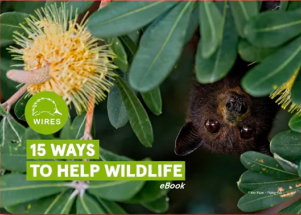Wildlife
Friendly
Fencing
- Home
- What We Do
- Wildlife Information
- General Information
- Wildlife Friendly Fencing
Make your fencing wildlife friendly
Each year thousands of animals face a cruel death entangled on barbed wire fences.
Many nocturnal animals like bats, gliders and owls fail to see the fence or cannot clear the height in windy conditions. Over 75 wildlife species have been recorded as fence victims, most caught on the top strand.
Kangaroos and emus can get hung up on plain wire and mesh fences. If the fence is too high, the animal's legs can become caught in a twist of wire. Low wires and tension droppers may prevent larger animals from squeezing through the fence.
Wildlife needs to move freely and safely across our landscape unless being purposely excluded for safety and other reasons.
When designing a fence, please consider the following:
Stop and think
Do you really need a fence? How will a fence affect the wildlife? If there are no animals to keep in or out, could a line of native trees do the job?
Avoid barbed wire
When fencing livestock, consider using a combination of plain wire and electric fencing. If using barbed wire, the main issues are fence placement, visibility and type of top strand, especially in entanglement hotspots.
Reduce tangle hotspots
To reduce the risk to wildlife, avoid placing barbed wire fences on ridge lines, near feed trees, across wildlife corridors, over or near water bodies.
To remedy an existing hotspot:
- replace barbs with plain wire
- cover barbs with split polypipe
- make the fence more visible.
Increase visibility
Wire gates are often hard to see and a danger to humans and wildlife. Plastic bags offer a short-term fix. A better way to improve visibility is to use white nylon sighter wires or white electric fence tapes that flicker in the breeze.
What can you do?
-
Wildlife-friendly fencing plays a vital role in allowing safe movement of native animals across the landscape, helping to reduce injuries, fatalities, and habitat fragmentation. Encourage wildlife friendly fencing in your local area. Talk to neighbours, councils, NRM groups, fencing contractors and suppliers.
-
To assist Council, landholders and contractors, below are some excellent resources that provide practical guidance on how to build wildlife-friendly fences:
- A short video on common fencing problems and solutions for wildlife: Watch here
- An informative video from NSW Local Land Services (LLS) explaining principles and examples of wildlife-friendly fencing: Watch here
- Terrain NRM’s Wildlife-Friendly Fencing Project, including brochures and additional guidance: View the Terrain brochure and resources
- The Wildlife Friendly Fencing National Website for more detailed information and design options: Visit here
- We strongly encourage Council to consider promoting these resources to the community and, where possible, to recommend or require wildlife-friendly designs in any fencing approvals or disaster recovery guidelines.
- Monitor barbed wire fences in your local area. Report any entangled animals to your local wildlife rescue organisation, found at www.fauna.org.au
Do not approach a trapped animal as it is likely to struggle and do more damage. Where possible, leave the rescue to an experienced carer who will untangle the animal with minimal further injury. Do not handle flying-foxes.
Reproduced with the permission of Tolga Bat Hospital
15 Ways to Help Wildlife
Sign up to receive our monthly eNewsletter with wildlife rescue stories and updates on our work rescuing, rehabilitating, and releasing native wildlife.
